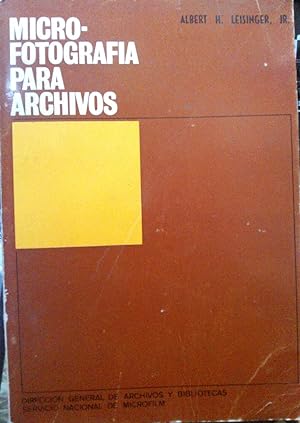ALBERT H LEISINGER, JR (2 resultados)
Tipo de artículo
- Todo tipo de artículos
- Libros (2)
- Revistas y publicaciones
- Cómics
- Partituras
- Arte, grabados y pósters
- Fotografías
- Mapas
-
Manuscritos y
coleccionismo de papel
Condición
- Todo
- Nuevos
- Antiguos o usados
Encuadernación
- Todo
- Tapa dura
- Tapa blanda
Más atributos
- Primera edición
- Firmado
- Sobrecubierta
- Con imágenes del vendedor (1)
- Sin impresión bajo demanda (1)
Ubicación del vendedor
Valoración de los vendedores
-
Microfotografía para archivos. Prólogo de Luis Sánchez Belba. Versión española de María del Carmen Guzmán
Publicado por Dirección General de Archivos y Bibliotecas, Servicio Nacional de Microfilm, Madrid, 1972
Librería: Librería Monte Sarmiento, Santiago, SANTI, Chile
Original o primera edición
Encuadernación de tapa blanda. Condición: Bien. 1ª Edición. 82 p. ; 19x14 cms. Bibliografía (A-161).
-
List of File Microcopies of the National Archives; National Archives Publication No. 51-5
Publicado por United States, General Services Administration, National Archives and Records Service, The National Archives, Washington DC, 1950
Librería: Ground Zero Books, Ltd., Silver Spring, MD, Estados Unidos de America
Libro Original o primera edición Impresión bajo demanda
Wraps. Condición: Good. v, [1], 67, [1] pages. Cover has some wear, soiling, and creasing. Rare surviving copy. Inferior reproduction at one time was available via print on demand. In the summer of 1950 the Archivist of the United States approved plans for the microphotographic reproduction of selected records in his custody, the retention by the National Archives of a file of the negative microfilm, and the sale, at cost, of positive prints made from these "file microcopies." The purposes of the program have been to make valuable archival sources available to investigators at a distance from Washington and to provide insurance against loss of valuable information in records in the event that the records themselves should be destroyed. At no time has the comprehensive development of the program been possible, however, and most of the file microcopies so far produced have had their origin in particular reference-service requests. Nevertheless, 3,478 rolls of 35-mm master negatives containing reproductions of more than 2 million pages, were completed by June 30, 1950 and those rolls are listed in this publication. This descriptive lists supersedes the List of File Microcopies published by the National Archives in 1947. The list is arranged, as shown in the table of contents, for the most part according to the organization of the government. Within each major unit the file microcopies are arranged by record group. The group containing the "General Records" of a department are listed first, and other record groups are arranged by the beginning date of the records in the microcopies. The compiler was Director of Exhibits and Publications. For all microcopies appropriate title pages and introductory notes have been prepared and filmed with the records. These introductory papers identify the records and, in addition, provide the investigator with information designed to facilitate his use of the microcopy. In some cases tables of contents, indexes, and special lists of the records microcopies have been included. The National Archives and Records Administration (NARA) is an independent agency of the United States government charged with the preservation and documentation of government and historical records. It is also tasked with increasing public access to those documents which make up the National Archive. NARA is officially responsible for maintaining and publishing the legally authentic and authoritative copies of acts of Congress, presidential directives, and federal regulations. NARA also transmits votes of the Electoral College to Congress. It also examines Electoral College and Constitutional amendment ratification documents for prima facie legal sufficiency and an authenticating signature. Originally, each branch and agency of the U.S. government was responsible for maintaining its own documents, which often resulted in the loss and destruction of records. Congress created the National Archives Establishment in 1934 to centralize federal record-keeping, with the Archivist of the United States serving as chief administrator. R.D.W. Connor was chosen to be the first leader of the organization. After a recommendation by the first Hoover Commission in 1949, the National Archives was placed within the newly formed General Services Administration (GSA). Presumed First Edition, First printing thus.



